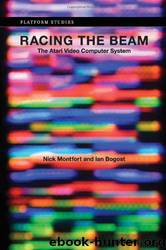Racing the Beam by Nick Montfort

Author:Nick Montfort [Montfort, Nick]
Language: eng
Format: mobi, epub
Tags: Personal Computers, Computer Graphics, Social Science, Computer Games - Programming, Popular Culture, Computers, Programming, Equipment and Supplies, General, Hardware, Video Game History, Game Programming & Design, Video Games - Equipment and Supplies, Games, Video Games - United States - History, vl-nfcompvg, Computer Games, Video Games, Atari 2600 (Video Game Console), Video & Electronic
ISBN: 9780262012577
Google: DqePfdz_x6gC
Amazon: 026201257X
Publisher: MIT Press
Published: 2009-03-31T00:00:00+00:00
5
Yars’ Revenge
[89]
5.1 At top, a screen from Star Castle, a vector graphics coin-op game. The screen at the bottom is from Yars’ Revenge, the Atari VCS cartridge that was inspired by Star Castle.
Details of the players’ ships are inset in each screen, showing signs of the different display technologies that are being used.
[90]
There are reasons for these intricacies that cannot be attributed solely to the programmer’s whim. Because there is only one button on the VCS
joystick, it is impossible to map one button to one type of weapon and another button to another, even though this type of setup was common on arcade games of the time— Tempest offered superzappers, Defender smartbombs. It was not an option to have one button for the Zorlon Cannon and one for regular fi ring. Instead, Yars’ Revenge has two different modes. In one, the button shoots the typical ordnance from the Yar, the energy missile; in the other, the button fi res the Zorlon Cannon, which follows the Yar horizontally but is fi xed to launch from the far left of the screen.
Although it might seem that complexity of this sort would inhibit new players, testing didn’t indicate any problems along these lines, and neither did sales. There are a few reasons why the nature of the game may not have put off new players. Cartridges were a costly investment, so any player who purchased the game was likely to check the manual out in some detail before declaring the game a dud. Players of the early 1980s would be more likely to read manuals for other reasons. Today’s players expect the game to teach them how to play, step by step, with live on-screen instruction via pointers and overlays. The Atari VCS has no built-in support for text rendering, and no programmer would have thought to waste precious ROM space with instructions. Instead, this aspect of the experience was offl oaded to the manual. Most VCS cartridges also included many variants— Combat’s twenty-seven video games, for example. To understand which variant was which, the player would have to consult a chart or description in the manual. An obvious fact that is nevertheless worth noting is that there was no World Wide Web in 1981, and the dial-up computer bulletin board services (BBS) had not yet become popular, so check-ing online to fi nd out how to play wasn’t an option.
But it wasn’t always necessary for players to consult the manual to learn a game’s intricacies. They could learn from someone else who had fi gured out how to play—even if that person hadn’t completely mastered the game or understood every detail. The complexity of play, rather than always shutting out newbies, sometimes offered an opportunity for those who had played a bit to discuss how the game worked. This sense of experimentation has not been entirely lost in contemporary video gaming, although times have certainly changed.
To continue pursuing the details of this game’s workings, consider the two options for attacking the shield.
Download
This site does not store any files on its server. We only index and link to content provided by other sites. Please contact the content providers to delete copyright contents if any and email us, we'll remove relevant links or contents immediately.
Deep Learning with Python by François Chollet(12957)
Hello! Python by Anthony Briggs(10198)
The Mikado Method by Ola Ellnestam Daniel Brolund(10107)
OCA Java SE 8 Programmer I Certification Guide by Mala Gupta(10044)
Dependency Injection in .NET by Mark Seemann(9581)
Algorithms of the Intelligent Web by Haralambos Marmanis;Dmitry Babenko(8588)
Grails in Action by Glen Smith Peter Ledbrook(7942)
Becoming a Dynamics 365 Finance and Supply Chain Solution Architect by Brent Dawson(7907)
Test-Driven iOS Development with Swift 4 by Dominik Hauser(7900)
The Well-Grounded Java Developer by Benjamin J. Evans Martijn Verburg(7843)
Microservices with Go by Alexander Shuiskov(7673)
Practical Design Patterns for Java Developers by Miroslav Wengner(7570)
Test Automation Engineering Handbook by Manikandan Sambamurthy(7506)
Angular Projects - Third Edition by Aristeidis Bampakos(6981)
Secrets of the JavaScript Ninja by John Resig Bear Bibeault(6739)
The Art of Crafting User Stories by The Art of Crafting User Stories(6438)
NetSuite for Consultants - Second Edition by Peter Ries(6384)
Demystifying Cryptography with OpenSSL 3.0 by Alexei Khlebnikov(6181)
Kotlin in Action by Dmitry Jemerov(5369)
